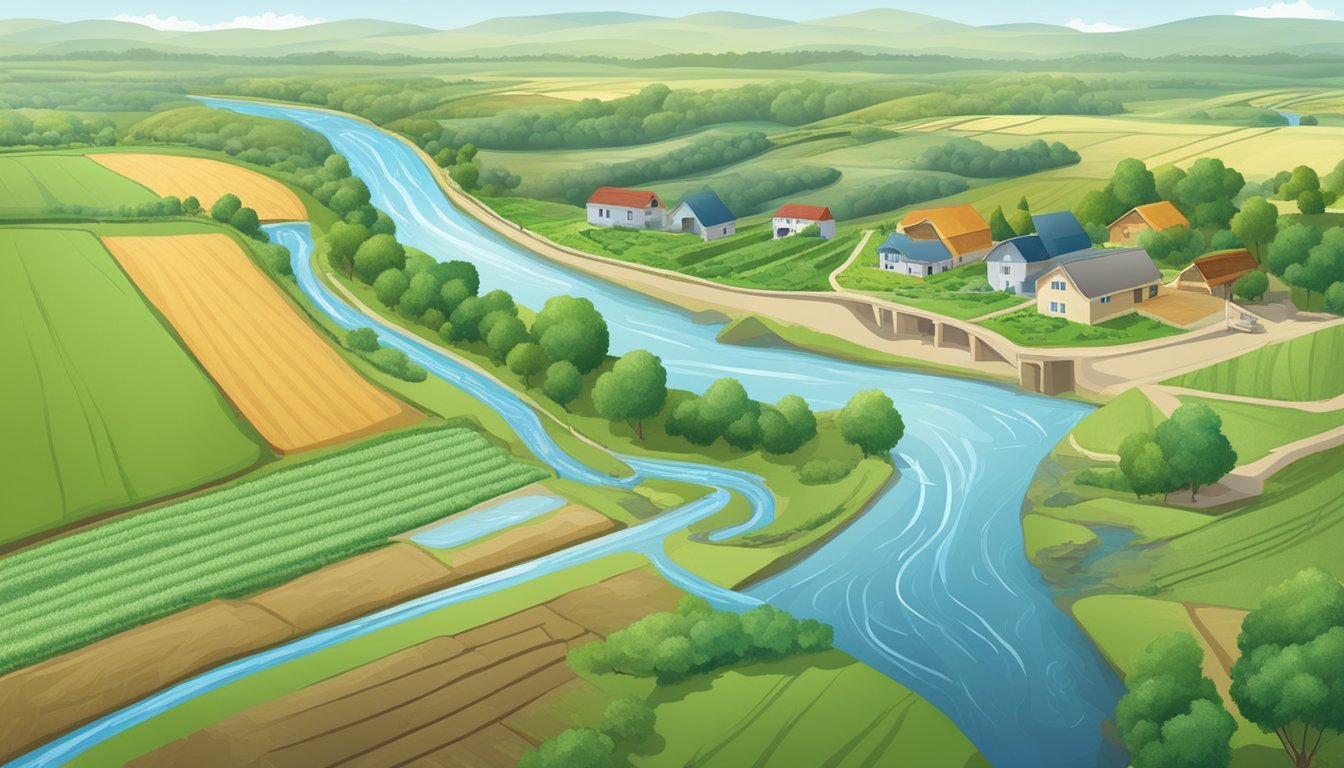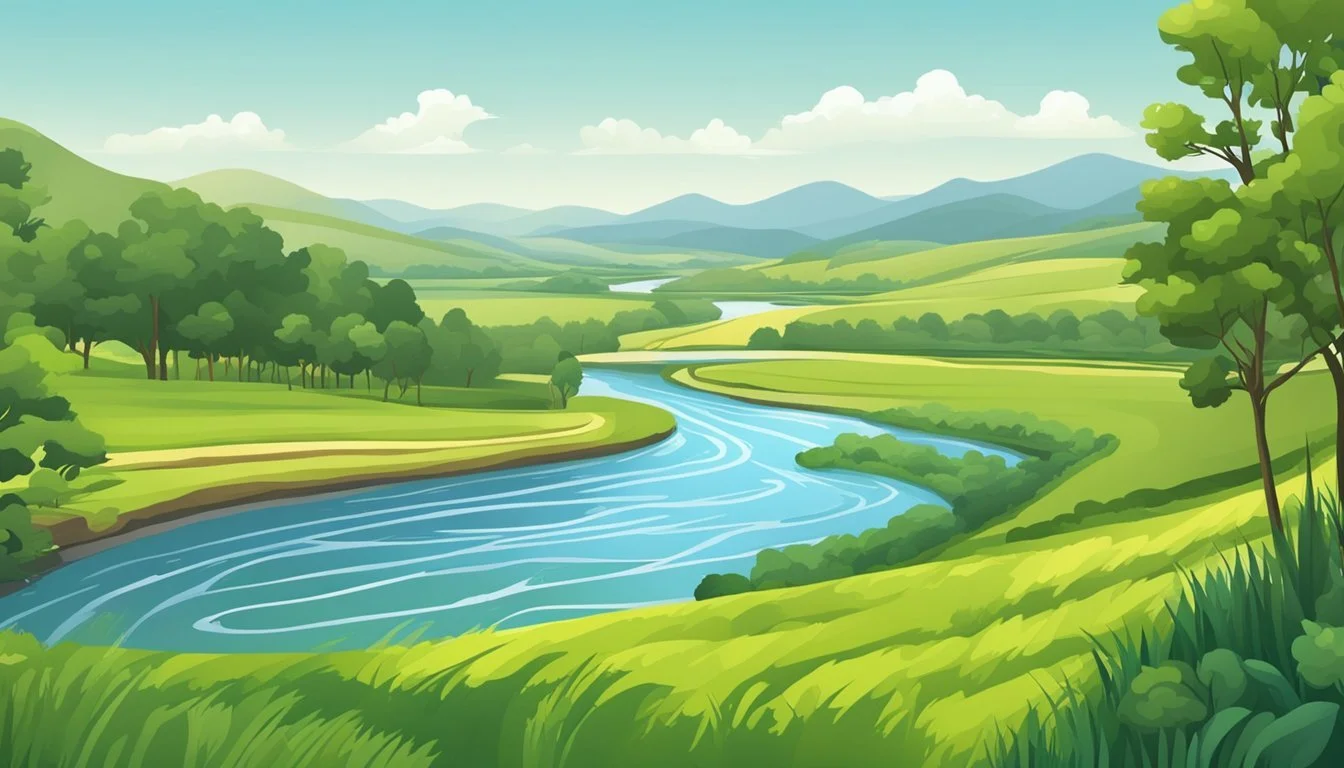Water Rights in Wisconsin
Navigating Policy and Ownership Issues
Water rights in Wisconsin are grounded in a complex legal framework that seeks to manage and protect the state's abundant water resources. The Public Trust Doctrine plays a central role in Wisconsin's water law, underscoring the principle that navigable waters are held in trust by the state for the benefit of all residents. This entails the safeguarding of rights to use these waters for transportation, recreation, and scenic enjoyment while balancing ecological protection. The Wisconsin Department of Natural Resources (DNR) is tasked with administering these regulations, ensuring that activities such as boating, fishing, hunting, and swimming can be enjoyed by the public without compromising water quality and aquatic habitats.
The legal nuances of water use, management, and regulation in Wisconsin are detailed in resources like "Wisconsin Water Law: A Guide to Water Rights and Regulations," which addresses issues from riparian rights to water quality standards. This guide offers an accessible avenue for landowners, lawyers, and water managers to understand their rights and responsibilities concerning water. As challenges and opportunities in water law continue to evolve, resources such as Wisconsin Lawyer Magazine provide insight into ongoing disputes and regulatory developments, reflecting the dynamic nature of water law in the state.
Wisconsin's dedication to water law is further exemplified by educational efforts, such as the University of Wisconsin-Madison's Law Library, which houses a collection of books and guides on the state's water regulations. These resources illustrate the state’s history of water rights and the comparison between riparian and appropriation doctrines. They serve as testimony to Wisconsin’s commitment to preserving both its water resources and the rights of its people through a comprehensive legal approach.
Legal Framework of Water Rights
Wisconsin's legal framework for water rights is built upon principles set forth in the state constitution, reinforced by the public trust doctrine, and detailed in various statutes and regulations. These laws collectively manage the utilization and protection of Wisconsin’s water resources, with a particular focus on navigable waters and water quality standards in line with the Clean Water Act.
Wisconsin Constitution
The Wisconsin Constitution provides the foundational legal context for water rights within the state. Specifically, it establishes that the waters of the state are held in trust by the state for the benefit of all residents, and this inherently includes navigable waters which are central to state water law. Property owners adjacent to these waters are granted riparian rights, subject to compliance with state regulations.
Public Trust Doctrine
Embedded deeply in the state's water rights regulation is the Public Trust Doctrine, a principle that asserts the state's responsibility in maintaining navigable waters for public use. Under this doctrine, the state ensures that activities on or use of navigable waters do not harm public interests, which range from navigation, fishing, and recreation to overall water quality and ecological health. This doctrine plays a pivotal role in preserving the balance between private water use rights and the public's interest.
Wisconsin Water Law
Wisconsin Water Law encompasses a range of statutes and regulations that govern water allocation and use. This includes provisions of the Clean Water Act, which the state enforces to protect water quality standards. Wisconsin Water Law oversees not only the surface water but also groundwater resources and wetlands, establishing the framework within which water rights and permits are issued. Detailed discussions on topics such as groundwater withdrawal, wetland restoration, and shoreland zoning can be found in comprehensive resources that describe the intent and administration of water laws in the state, helping landowners, businesses, and policymakers navigate complex regulatory landscapes.
Regulatory Authorities in Water Rights
In Wisconsin, water rights and management are principally overseen by two key regulatory bodies: the Department of Natural Resources (DNR) and the U.S. Army Corps of Engineers. These entities ensure the adherence to regulations, issuing various permits and deploying staff to supervise water use and conservation initiatives.
Department of Natural Resources (DNR)
The Wisconsin Department of Natural Resources (DNR) holds the primary responsibility for regulating state water resources. It implements and enforces water quality standards and offers permits for activities impacting waterways, wetlands, and public waters. Guided by the Public Trust Doctrine, the DNR ensures that water use does not harm the environment or infringe on public rights. They maintain a comprehensive framework that addresses groundwater withdrawal, shoreland zoning, and wetlands protection, working with a dedicated staff to oversee compliance.
U.S. Army Corps of Engineers
The U.S. Army Corps of Engineers plays a crucial role in managing and protecting Wisconsin's water resources on a federal level. Their purview includes navigable waters and activities with potential impacts on interstate waters and related wetland areas. The Corps issues permits, such as the Section 404 permit for the discharge of dredged or fill material into waters, including wetlands, ensuring activities align with the Clean Water Act. Specialized staff within the Corps assess permit applications to uphold environmental standards and support sustainable development.
Water Rights and Property Ownership
In Wisconsin, water rights are inherently linked to land ownership, with specific laws governing the intersection between private property and water use. These laws are vital for both riparian landowners and the general public, as they define the extent of access and usage of water bodies adjacent to land.
Riparian Rights
Riparian rights are afforded to landowners whose property is adjacent to a body of water. These rights grant landowners the ability to make reasonable use of the water which may include activities like swimming, boating, and fishing. For example, the Wisconsin DNR explains that these rights come with the responsibility not to harm downstream or adjacent properties. Moreover, these rights do not allow for the obstruction of navigation or exclusive use, as water bodies are held in trust for the public.
Ordinary High Water Mark
The Ordinary High Water Mark (OHWM) is a crucial concept in property law, delineating where riparian rights extend. It is recognized as the point where the water leaves a "distinct mark" indicating a border between public and private usage of the shoreline. This mark defines the boundary between the land subject to private property rights and the public trust area, where the land is reserved for public use and enjoyment. Understanding and identifying the OHWM is essential for any landowner or property law professional in Wisconsin to ascertain the extent of private property and corresponding riparian rights.
Water Use and Management
In Wisconsin, the intricate interplay of legal frameworks, environmental considerations, and practical usage dictates the policies for water use and management. The overall governance ensures water quality is maintained, supply meets demand, and ecosystems, specifically wetlands, are safeguarded.
Water Quality and Pollution Control
Wisconsin’s approach to water quality is underpinned by regulations that align with the Clean Water Act's Section 401. This mandates state certification for any federal license or permit applicants proposing activities that may result in a discharge into waters, thus ensuring ongoing pollution control efforts. Monitoring and remediation programs are in place to handle contaminants and protect both groundwater and surface water resources.
Water Withdrawal and Use
The state administers strict guidelines on water withdrawal, especially for significant withdrawals, which are those surpassing 100,000 gallons per day. Users must adhere to the principle of reasonable use, meaning water usage should not disrupt the ecosystem or deprive others. This applies universally to individuals, industries, and agricultural stakeholders withdrawing from available groundwater and surface water reservoirs.
Groundwater and Surface Water Relations
Understanding the symbiotic relationship between groundwater and surface water is essential for effective management. Wisconsin recognizes that excessive withdrawal of groundwater can impact surface water bodies and vice versa. There are statutes and provisions in place endeavoring to balance out this relationship, thus preventing one resource from being exploited at the cost of the other.
Wetlands Protection
Wetlands hold particular significance in Wisconsin's water management strategy. These crucial ecosystems are protected through both state regulations and federal stipulations found in the Clean Water Act. Any activity that potentially alters wetlands must undergo a thorough review process, emphasizing the necessity to maintain their integrity, which includes managing water quality and addressing pollution threats.
These sections collectively capture Wisconsin's structured approach towards maintaining the integrity of its water resources while accommodating equitable and sustainable usage.
Development and Land Use
In Wisconsin, development and land use near waterways are tightly regulated to protect both riparian rights and the environment. It's imperative that developers and landowners understand the legal framework governing the impact of construction, the planning requirements for land use, and the considerations necessary for agricultural practices near water bodies.
Construction Impact on Waterways
When it comes to construction, it must be conducted with care to avoid adverse effects on Wisconsin's waterways. The watershed's health hinges on minimizing erosion and preserving the natural flow of the water. Developers are required to obtain relevant permits and adhere to regulations that aim to shield water quality from the ramifications of construction activities.
Land Use Planning and Water Rights
Land use planning in Wisconsin integrates water rights to ensure that use of land adjacent to waterways respects the public trust doctrine. This doctrine underlines the fundamental premise that navigable waters are held in trust by the state for the benefit of all citizens. Zoning laws and land use policies offer guidance for sustainable development without compromising the collective rights to water.
Agricultural and Livestock Considerations
Agriculture often requires significant water usage, but in Wisconsin, agricultural practices and livestock rearing must comply with water law. This includes compliance with water quality standards and managing runoff to prevent nutrients or contaminants from entering adjacent waterways. Farmers hold the responsibility to balance their water needs with the rights of others and the ecological integrity of water resources.
Environmental Considerations
Wisconsin's water rights are deeply intertwined with environmental concerns, such as the impact of climate change on water resources and the protection of aquatic habitats. These factors are critical to the use and stewardship of the state's waterways, affecting everything from boating to wildlife preservation.
Climate Change and Water Resources
Climate change significantly affects water resources in Wisconsin. It not only alters hydrological cycles but also impacts water availability and quality. As temperatures rise, evaporation increases, potentially leading to lower water levels, which can hinder activities like boating and fishing. Warmer temperatures can also exacerbate the proliferation of harmful algal blooms, which compromise water quality for swimming and aquatic life.
Aquatic Habitat and Wildlife Protection
Protecting aquatic habitats is essential for preserving Wisconsin's rich biodiversity and maintaining the health of its waterways. Regulations such as the Public Trust Doctrine ensure that navigable waters remain a public resource for activities like fishing, hunting, and swimming. Efforts to safeguard these habitats support the various species depending on them, while also promoting clean water initiatives that benefit the entire ecosystem. These measures are not only vital for wildlife protection but also contribute to the quality of life for residents and the overall ecological balance.
Navigation and Recreation
In Wisconsin, the right to freely navigate the waterways aligns closely with recreational use, offering various activities like boating, swimming, and fishing. These uses are grounded in legal doctrine and historical precedent, ensuring public access and enjoyment of the state's scenic waters.
Navigable Waters and Public Use
Wisconsin’s Public Trust Doctrine enshrines the public's right to use its navigable waters for activities such as transportation, navigation, and recreational pursuits including fishing, boating, and swimming. Navigable waters, defined by their ability to support recreation or commerce, are held in trust by the state for the benefit of all residents. This encompasses a broad spectrum of water bodies, from mighty rivers to meandering streams, which are subject to state regulation to protect these uses and the natural scenic beauty they offer.
Rights to use navigable waters:
Transportation
Navigation
Recreation (boating, fishing, swimming)
Enjoyment of scenic views
These rights are not without limits; certain structures like dams can be erected, but they must not interfere with the public's use nor harm water quality and aquatic habitats.
Historical Significance of Waterways
The significance of Wisconsin's waterways is rooted in the Northwest Ordinance of 1787 and the state's constitution in 1848 which established the framework for public waterway use. These historical documents codified the belief that waterways were to serve the public good, a perspective reinforcing the Public Trust Doctrine. Navigable waters have historically been arteries of commerce and transport, while also providing critical resources for the populace.
As time has passed, these waterways have remained pivotal not only to Wisconsin's economy but also to its identity, preserving the right for boating, fishing, and swimming for both practical and recreational purposes. The stewardship of these waters ensures their continued significance for future generations.
Water Infrastructure
Water infrastructure in Wisconsin encompasses a range of structures essential for managing the state's aquatic resources. It includes not only the physical components like dams and bridges but also the engineering efforts behind stormwater management systems, all aiming to sustainably balance human and environmental needs.
Dams and Bridges
Wisconsin is home to numerous dams, constructed to serve multiple purposes such as creating reservoirs, preventing floods, and generating hydroelectric power. Engineers oversee the design, construction, and maintenance of these dams, ensuring they meet safety standards and contribute to water regulation. Bridges, often integrated with dam structures, facilitate transportation across waterways, connecting communities and boosting local economies.
Stormwater Management
Stormwater management is critical for mitigating flooding risks and protecting water quality. In Wisconsin, infrastructure such as retention basins, permeable pavements, and green roofs are utilized. These structures allow stormwater to be collected and slowly released or absorbed, reducing the burden on sewer systems and natural waterways.
Legal and Administrative Processes
The Legal and Administrative Processes regarding water rights in Wisconsin involve a detailed system of permitting and registration, backed by a robust framework of case law and secondary resources. These processes are designed to manage the use and conservation of water resources across the state effectively.
Permitting and Registration
In Wisconsin, individuals or entities seeking to utilize water for various purposes must navigate a comprehensive system of permits and registration. Depending on the volume and purpose of water use, permits are generally required for water withdrawals affecting state water bodies. The Wisconsin Department of Natural Resources (DNR) provides detailed requirements and procedures for these permits. Registration, on the other hand, is often necessary for smaller water withdrawals and is subject to different criteria and processes.
Case Law and Secondary Resources
Case law plays a crucial role in shaping Wisconsin’s water law. Key judicial decisions help interpret statutes and administrative rules, influencing water rights and regulations enforcement. Practitioners rely on secondary resources, such as treatises and journals, to stay informed about legal precedents and evolving legal principles. These resources include state-specific publications, such as the "Wisconsin Water Law: A Guide to Water Rights and Regulations", and legal periodical databases which offer insights from experienced professionals on the complexities of water law in Wisconsin.
Interstate Agreements and Policies
Wisconsin engages in interstate agreements to manage shared water resources effectively and ensure compliance with federal standards for water quality and usage.
Great Lakes Compact
The Great Lakes Compact is a binding agreement between the states of Illinois, Indiana, Michigan, Minnesota, New York, Ohio, Pennsylvania, and Wisconsin, along with the Canadian provinces of Ontario and Quebec. This compact was designed to protect the Great Lakes from excessive withdrawals and manage the use of the basin's water supply. The agreement particularly addresses issues related to wastewater treatment and diversion, ensuring sustainable use of this vital resource.
Cross-border Water Management
Cross-border water management refers to the strategies and collaborations between Wisconsin and its neighboring states and provinces. Coordination is critical when dealing with shared water bodies to address challenges like water quality and the ecological integrity of interconnected water systems. This includes governance through shared legislation and regulations, which are key to maintaining a consistent approach to water rights and access across state lines. Additionally, these agreements work to balance the water needs of communities with the preservation of aquatic ecosystems.
Public Health and Welfare
In the state of Wisconsin, water law is deeply intertwined with public health and welfare. Water is not merely a property right but also a critical resource that has a direct impact on the community's health and quality of life. The legal framework concerning water rights and regulations is designed with the public's health and welfare in mind.
The Wisconsin Department of Natural Resources (DNR) plays a pivotal role in the protection of water sources to ensure that they are clean and safe for public use. Legal actions can be brought against private parties by citizens under the public trust doctrine when it is believed that the DNR oversight is inadequate, an aspect of water law that underscores its significance to public wellbeing.
Natural streams and lakes: Water bodies are safeguarded to serve as reliable sources of drinking water and to maintain ecological balance.
Artificial streams and lakes: Man-made reservoirs and lakes are monitored and regulated to prevent pollution.
Diffused surface water: Runoff is managed to reduce contaminants entering water bodies.
Groundwater: Vital for drinking and agriculture, groundwater is protected to prevent over-extraction and contamination.
Wetlands: These critical ecosystems are preserved for their role in water purification and flood control.
Through such classifications and oversight, Wisconsin law reflects a commitment to safeguarding water as a public health resource, ensuring that every individual has access to clean water, contributing to the overall well-being of its citizens.
Resources and Further Reading
For those seeking comprehensive information on Wisconsin water laws, a variety of resources are available. These range from official government documentation to expert legal advice, ensuring a breadth of information for different needs.
Official Documentation and Websites
State Resources:
The Wisconsin Department of Natural Resources provides substantial material focused on state water regulations, permits, and guidelines that affect Wisconsin's lakes, streams, and wetlands. Essential for landowners and professionals alike, its resources are foundational in understanding local water rights.
Educational Publications:
Documents such as "Wisconsin Water Law: A Guide to Water Rights and Regulations" offer detailed analyses of current laws including riparian rights, the public trust doctrine, and water usage policies, providing a scholarly perspective on managing and using water resources.
Professional Services and Legal Assistance
Lawyer Expertise:
Legal practitioners specializing in environmental law can provide personalized guidance and assistance. The State Bar of Wisconsin is an excellent starting point to find qualified lawyers experienced in water law and related disputes.
Consulting Services:
Professional services offer nuanced support for complex matters such as shoreland zoning or navigating state and federal water regulations. Consulting with experts who provide these services ensures compliance and protection of water-related interests.
Frequently Asked Questions
Water rights in Wisconsin hinge on a complex legal framework designed to balance private property interests with public resource management. These FAQs address the specifics of water rights for landowners and residents.
What constitutes riparian rights for waterfront property owners in Wisconsin?
In Wisconsin, riparian rights pertain to landowners whose property abuts a body of water, granting them the usage of water for reasonable domestic purposes, along with access for recreational activities. More comprehensive details can be found in the Wisconsin Water Law guide.
How does the Public Trust Doctrine influence water rights and usage in Wisconsin?
The Public Trust Doctrine plays a crucial role by ensuring that all navigable waters remain open for public use. Wisconsin's application of the doctrine includes the protection of water quality and aquatic habitats, and it empowers the state to manage these resources for public benefit.
What are the regulations for tree removal near shorelines as enforced by the Wisconsin DNR?
The Wisconsin Department of Natural Resources enforces specific shoreland zoning regulations aimed at protecting waterways. These regulations limit tree removal within a defined distance from the shoreline to prevent erosion and preserve water quality.
How do property boundaries affect water access and use for lakeside landowners in Wisconsin?
Property boundaries in Wisconsin are critical in determining water access and use for lakeside landowners. While owners have rights to water access, their activities are subject to state regulations designed to safeguard the ecosystem and public rights. Boundaries are typically delineated by the Ordinary High Water Mark.
Under what conditions does the Ordinary High Water Mark determine land use in Wisconsin?
The Ordinary High Water Mark (OHWM) delineates the point where the shore property ends and public ownership begins, dictating land use rights. Activities below the OHWM are subject to state oversight, ensuring adherence to environmental standards and public access rights.
What are the legal implications of the 'wet foot' rule for Wisconsin residents?
The 'wet foot' rule in Wisconsin implies that individuals have the right to walk along the shores of navigable waters below the OHWM without trespassing on private property. This ensures the public's ability to enjoy the natural resources, while respecting private property upland of the high water mark.











